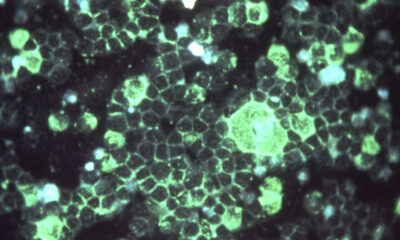Health
The WHO is expanding which pathogens can be transmitted through the air

IIn the chaotic early months of the Covid-19 pandemic, stores faced shortages of all kinds: toilet paper, canned food and, most importantly, cleaning products. When everyone was scrubbing out their groceries, mail, and even library books, I then had good luck finding antibacterial wipes or disinfectant sprays. That’s because public health advice in early 2020 focused on disinfecting surfaces, rather than protecting against a virus that could spread through the air.
Much of that guidance traced back to the World Health Organization, which stated early and unequivocally that Covid-19 was not an airborne disease. Even as evidence grew that coronavirus-contaminated particles could linger in the air indoors and infect nearby people and researchers raised the alarm On the risks this posed to healthcare workers and the general public, the WHO did not acknowledge that Covid was airborne until late 2021.
Part of what took so long was a deep-seated disconnect between the way different types of scientists and doctors use words like “aerosol,” “airborne,” and “airborne transmission.” Those disagreements sowed confusion and escalated into a series of ugly skirmishes on social media.
To address the confusion and resulting controversy, the WHO brought together a group of experts in November 2021 to update its formal guidelines for classifying the different routes that pathogens take from one person to another.
That group published Thursday, after more than two years of discussions a report outlining a new set of definitions that more accurately reflect the state of the science of disease transmission. The experts divided transmission into routes involving direct contact by touching infected surfaces or other people and others involving the air. This latter route was termed “airborne” and was further subdivided into “direct deposition”, which refers to larger particles that touch the mucous membranes of the eyes, nose or mouth and “airborne/inhalation transmission”, where smaller particles are inhaled into the lungs.
Until now, the WHO’s position has been to reserve the term “airborne” for only a few select pathogens that have been shown to float in the air and infect people over long distances, such as measles and tuberculosis. Most respiratory pathogens were found to spread via “droplet transmission,” in which infectious droplets are projected from a sick person through a cough or sneeze and land directly on a bystander’s mouth, eyes, or nose.
The updated guidelines do not depend on droplet size or distance spread – and the changes could have major and expensive implications for how countries set infection control standards and prevention measures in the future.
“It was controversial at times,” said Linsey Marr, an environmental engineer at Virginia Tech and a member of the advisory group. She admitted that some of the language is “clunky,” but the important thing is that the science is right, she said. “In terms of communicating with the public, the most important thing to come from this is that we can now say the word in the air. Previously, public health officials tiptoed around that word and people didn’t understand why.”
Remarkably, the group included not only experts in public health and medicine, but also engineers and aerosol scientists—people like Marr who study at a fundamental, physical level how viruses move in and out of bodies and through the environment.
“That is a perspective that WHO has lacked in the past,” she said.
The long-standing tradition among medical professionals and infection control experts has been to draw a hard line between viruses that can linger in the air in particles smaller than 5 microns, and viruses that can travel only over a short range move in ballistic droplets. Small equals air in the air, equals isolation rooms in hospitals, respirators and other costly control measures. Big equals drop equals washing hands, keeping your distance and hoping for the best.
But in recent decades, engineers and other scientists who study the physics of disease transmission have done just that discovered that the 5 micron distinction was flawed. In fact, infectious particles exist on a spectrum of sizes, and dense clouds of small particles can infect people even at close range. The new guidelines reflect that reality.
“It’s a step in the right direction, especially if we get on the same page in recognizing that distance doesn’t tell you much about the mode of transmission,” said Don Milton, an occupational physician who studies the transmission of infectious diseases by aerosols at the University of New York. Maryland and another member of the advisory committee.
Although the group reached consensus on the definition of terms, it did not reach agreement on the implications of these definitions for informing infection prevention and control policies.
The report noted that effectively countering the risk of disease spread from smaller infectious respiratory particles at both short and long distances would require masks, isolation rooms and other substantive measures, currently called “airborne precautions.” But it did not recommend using such measures in all situations involving pathogens that can spread through the air.
“What I think this really needs in response to this is a much more nuanced risk assessment that takes into account the three modes of transmission and the levels of morbidity and mortality that result from infection and the risk profile of the population you’re trying to target to protect. Milton said. “But that makes it very complicated. The problem really is that practitioners tend to want something black and white.”
Jose-Luis Jimenez, an aerosol chemist at the University of Colorado Boulder, has been an outspoken critic of the WHO’s position on Covid transmission. “The bigger battle is when should you protect against inhalation? That’s what they basically said here,” he said.
Now that that remains unresolved, his concern is that little will actually change; that economic and political forces will overwhelm science and people will continue to get sick and suffer so that hospitals and other businesses don’t have to invest in cleaner indoor air. But he also feels relief that global health has finally embraced disease transmission as a multidisciplinary problem.
“It feels like finally the end of the most stubborn and futile resistance to accepting this science,” Jimenez said. “Everything we build now, we build on the right foundation. It’s also frustrating that it took so long. But it is good. It is progress.”
At a press conference Thursday morning, WHO chief scientist Jeremy Farrar did not shy away from saying that there is still a lot of work to be done. “This is base camp,” he said. From here, he emphasized the importance of keeping this multidisciplinary group of experts together to conduct more scientific research to improve infection control practices for the diseases we know today and the new infections we may face in the future.
“I don’t think we could have done that two years ago with a diverse group of people,” Farrar said. “I think we can do that now because there is agreement on the terminology.”













